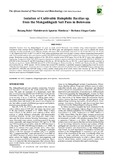Please use this identifier to cite or link to this item:
http://hdl.handle.net/10311/920| Title: | Isolation of cultivable halophilic Bacillus sp. from the Makgadikgadi Salt Pans in Botswana |
| Authors: | Baloi, B. Matsheka, M.I. Gashe, B.A. |
| Keywords: | 16S rRNA Halophiles Makgadikgadi pans Novel species Thalassobacillus |
| Issue Date: | 2011 |
| Publisher: | Global Science Books, http://www.globalsciencebooks.info/ |
| Citation: | Baloi, B. et al. (2011) Isolation of cultivable halophilic Bacillus sp. from the Makgadikgadi Salt Pans in Botswana, The African Journal of Plant Science and Biotechnology, Vol. 5 (Special issue 1), p. 21-25 |
| Abstract: | Halophilic bacteria from the Makgadikgadi salt pans in north central Botswana were isolated using culture-dependent methods. Polymerase chain reaction (PCR) amplification of the 16S rRNA gene and phylogenetic analysis were used to identify the strains. Culturing was done aerobically in six different complex salt media. Salt concentrations used were 1Halophilic bacteria from the Makgadikgadi salt pans in north central Botswana were isolated using culture-dependent methods. Polymerase chain reaction (PCR) amplification of the 16S rRNA gene and phylogenetic analysis were used to identify the strains. Culturing was done aerobically in six different complex salt media. Salt concentrations used were 15, 20, 25 and 30% (2.6, 3.4, 4.3 and 5.1 M, respectively) NaC1, at pH 7.2 to pH 8.0. Four colony morphology types were isolated in axenic cultures comprising Gram-positive cells. Universal bacterila primers were used to amplify 16S rDNA from chromosomal DNA isolated from three of the four distinct colony groups. Restriction enzyme digest analysis of the 16S rDNA revealed seven RFLP types. Five of the RFLP types were subjected to sequencing. Comparison of the 16S rDNA sequence alignment to reference sequence data bases showed samples S2012A3, S2012B2 and S2012B3 to have between 95 and 99% homology to Bacillus sp. BH 164 and Bacillus sp. HS 136T, a novel species recently described as Bacillus persepolensis. Isolate S4102D4 showed 95 to 99% homology to Thalassobacillus sp. JY0201 and Thalassobacillus sp. FIB228 and Halobacillus sp. MO56 species. All five isolates had at least 95% similarity to published sequences implying they could be species within the described genera. A sub-tree drawn to compare the isolates indicated two phyletic lines with S4102D4 being an outlying strain and S2012A3, S2012B and S2012B3 being a closely related clonal group all of which branch from Bacillus sp. BH 164. Pending conclusive culture, biochemical and polar lipid composition data these microorganisms are regarded as previously un-described and therefore novel species of halophilic bacteria. |
| URI: | http://hdl.handle.net/10311/920 |
| ISSN: | 1752-3931 (Print) |
| Appears in Collections: | Research articles (Dept of Biological Sciences) |
Files in This Item:
| File | Description | Size | Format | |
|---|---|---|---|---|
| Matsheka_AJPSB_2011.pdf | 513.55 kB | Adobe PDF |  View/Open |
Items in DSpace are protected by copyright, with all rights reserved, unless otherwise indicated.
